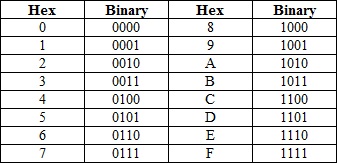Unlike IPv4, which uses a dotted-decimal format with each byte ranges from 0 to 255, IPv6 uses eight groups of four hexadecimal digits separated by colons. For example, this is a valid IPv6 address:
2340:0023:AABA:0A01:0055:5054:9ABC:ABB0
If you don’t know how to convert hexadecimal number to binary, here is a table that will help you do the conversion:
IPv6 address shortening
The IPv6 address given above looks daunting, right? Well, there are two conventions that can help you shorten what must be typed for an IP address:
1. a leading zero can be omitted
For example, the address listed above (2340:0023:AABA:0A01:0055:5054:9ABC:ABB0) can be shortened to 2340:23:AABA:A01:55:5054:9ABC:ABB0
2. successive fields of zeroes can be represented as two colons (::)
For example, 2340:0000:0000:0000:0455:0000:AAAB:1121 can be written as 2340::0455:0000:AAAB:1121
You can shorten an address this way only for one such occurrence. The reason is obvious – if you had more than occurence of double colon you wouldn’t know how many sets of zeroes were being omitted from each part.
Here is a couple of more examples that can help you grasp the concept of IPv6 address shortening:
Long version: 1454:0045:0000:0000:4140:0141:0055:ABBB
Shortened version: 1454:45::4140:141:55:ABBB
Long version: 0000:0000:0001:AAAA:BBBC:A222:BBBA:0001
Shortened version: ::1:AAAA:BBBC:A222:BBBA:1
Download our Free CCNA Study Guide PDF for complete notes on all the CCNA 200-301 exam topics in one book.
We recommend the Cisco CCNA Gold Bootcamp as your main CCNA training course. It’s the highest rated Cisco course online with an average rating of 4.8 from over 30,000 public reviews and is the gold standard in CCNA training:

